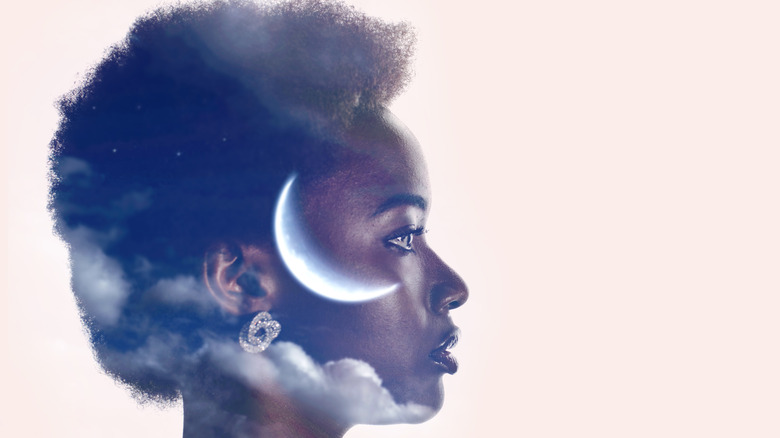The Four Stages Of Your Menstrual Cycle And What They Mean
Just as the earth and the moon have their seasons and cycles, so does a woman's body. Each stage requires different activity levels for optimal health and well-being. While women have long felt the capitalistic pressure from society to go, go, go — no matter which stage of the menstrual cycle they're in — many are reconnecting with their innate wisdom and slowing down during certain phases, finding themselves in far better balance, both hormonally and emotionally. Some might not be aware that there's much more to the menstrual cycle than menstruation, and haven't been taught the tools and tips to nourish the body through the whole cycle, which is 28 days long on average (via Insider).
From improved results when trying to conceive, to a smoother premenstrual experience, understanding the waves of the menstrual cycle can be life-changing (via The Women's Wellness Collective). Here's a closer look at the four stages of the menstrual cycle and what they mean.
Menstrual phase
The first stage of the menstrual cycle is menstruation. This is when your period starts, as there wasn't an egg fertilized in the last cycle and the lining of the uterus is shed, since it isn't needed to support a pregnancy (via Healthline).
So, what's the best route to nourish yourself during this stage? The body is shedding and bleeding, which means it's a good idea to rest. All those tampon commercials over the years featuring women running marathons while on their periods weren't exactly doing us any favors.
You'll also want to replenish your body with iron-rich foods. Leafy green vegetables, dark chocolate, and red raspberry leaf tea are all great options when consumed in moderation (via The Women's Wellness Collective).
In terms of activity levels, gentle yoga, walking, and getting enough sleep are key to supporting your health during this stage, which some refer to as the winter of the menstrual cycle.
Follicular phase
The follicular phase overlaps with the menstrual phase, beginning on day one of the period and lasting about 16 days (via Healthline). During this time, follicle-stimulating hormone (FSH) is released, which signals the ovaries to produce follicles containing immature eggs. Generally speaking, only the healthiest egg of the bunch will mature, while the rest are absorbed back into the body. Estrogen then thickens the lining of the uterus, creating an environment full of nutrients for an embryo to thrive in.
If you were holding out on those intensive workouts before, once your bleeding has stopped, it's the time to dive in. Women have a renewed energy during this part of the cycle and creative projects are likely to be most successful when tackled at this time, which is why this phase represents spring. Nourishing the body with high-protein foods and healthy fats is ideal. Nettle tea is also super supportive during this phase (via The Women's Wellness Collective).
Ovulatory phase
During ovulation, the ovary releases a mature egg. The egg then makes its journey through the fallopian tube to the uterus to be fertilized. If it isn't fertilized, it'll dissolve (via Healthline). This phase typically occurs in the middle of the cycle, around day 14.
Eating lighter foods during this time is wise, as the body can begin to feel lethargic. Vegetables, rice, quinoa, and fish are good go-to foods. Hip-opening yoga positions will be your best friend here if you struggle with aches and pains as that egg moves down the fallopian tube.
This is also when many women tend to be their most social, energetically. The ovulatory phase represents summer. So, if you plan outings or date nights during ovulation, you may enjoy yourself far more than in other phases (via The Women's Wellness Collective).
To confirm you're ovulating, you can check for an elevated basal body temperature. Increased libido is another indicator. Women are most likely to become pregnant around this time.
Luteal phase
The final stage of the cycle is the luteal phase. After the egg is released during ovulation, the remainder of the follicle turns into something called corpus luteum, which is a mass of cells that produces progesterone, thickening the uterine lining.
If you don't become pregnant, the corpus luteum dissolves, causing a drop in hormones that will lead to the start of your period. You may experience PMS symptoms during this time, as menstruation is coming next (via Healthline). But, hopefully, with some nourishing measures in place, symptoms like cramping and moodiness should be smooth and mild.
You might start to slow down here as you would in the autumn, preparing for the hibernation of menstruation, but some light activity can be helpful to keep your mood balanced. You may feel more introverted and crave solitude. Meditation, massage, and journaling are all encouraged (via The Women's Wellness Collective).
You may find yourself to be extra sensitive to substances like caffeine and alcohol during this time. Staying hydrated is also particularly important in the luteal phase.




